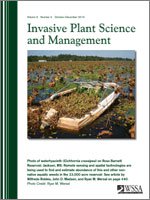Genetic diversity and reproductive characteristics may play an important role in the invasion process. Here, we review the genetic structure and reproductive characteristics of common reed and giant reed, two of the most aggressive, large-statured invasive grasses in North America. Common reed reproduces both sexually and asexually and has a complex population structure, characterized by three subspecies with overlapping distributions; of which, one is introduced, one native, and the third is of unknown origins. These three subspecies show varying levels of genetic diversity, with introduced common reed having high levels of nuclear diversity, indicating that multiple introductions have likely occurred. In contrast, giant reed has low genetic diversity and appears to reproduce solely via asexual fragments yet is highly aggressive in parts of its introduced range. Both species are well-adapted for growth in human-dominated landscapes, which is presumably facilitated by their rhizomatous growth habit.
Nomenclature: Common reed, Phragmites australis (Cav.) Trin. ex Steudel; giant reed, Arundo donax L





